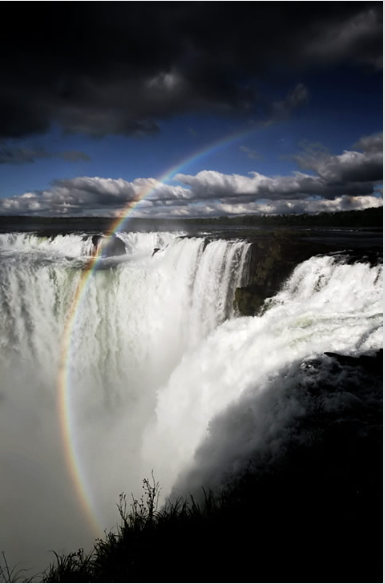Igauzu Falls Falls Rainbow
The Spectacular Igauzu Falls Rainbow
Igauzu Falls, located on the border of Argentina and Brazil, is renowned for its breathtaking beauty and natural wonders. Among the many captivating sights at this magnificent waterfall is the mesmerizing phenomenon of the Igauzu Falls Rainbow. While we typically observe only a portion of a rainbow, the Igauzu Falls Rainbow presents a rare opportunity to witness the complete circle of this ethereal optical wonder.
When gazing upon the Igauzu Falls Rainbow, it becomes evident that the full circle of colors is indeed present. This unique spectacle challenges our perception of rainbows, which are typically seen as semi-circular arcs. The Igauzu Falls Rainbow serves as a captivating reminder of the vastness and complexity of the natural world.
One fascinating aspect of the Igauzu Falls Rainbow is its illustration of the impact of drop size on the appearance of the rainbow. As we descend into the gorge beneath the falls, we can observe that the rainbow appears noticeably broader where smaller mist droplets form it. This phenomenon occurs due to the effects of diffraction, which become more prominent as droplets decrease in size. The diffraction causes the rainbow to broaden, shrink slightly in radius, and exhibit less intense colors.
The Igauzu Falls Rainbow offers a captivating demonstration of the interplay between light, water droplets, and atmospheric conditions. Understanding this phenomenon requires delving into the science of atmospheric optics. By exploring the intricate processes that contribute to the formation and appearance of rainbows, we can gain a deeper appreciation for the beauty and complexity of our natural surroundings.
In essence, rainbows are formed when sunlight interacts with water droplets suspended in the air. As sunlight enters a water droplet, it undergoes refraction, bending as it passes from one medium to another. The bent light then reflects off the inside surface of the droplet before exiting and dispersing into its component colors. This dispersion of light creates the iconic arc shape that we associate with rainbows.
The size of the water droplets plays a crucial role in determining the characteristics of a rainbow. Larger droplets tend to produce more vibrant and distinct colors, while smaller droplets result in a broader and less intense rainbow. Additionally, the angle at which sunlight enters the droplets affects the size and position of the rainbow in the sky.
The unique setting of Igauzu Falls provides an ideal environment for the formation of the spectacular rainbow. The mist created by the cascading waterfalls produces a multitude of tiny water droplets that are perfect for creating a broad and vivid rainbow. As these mist droplets interact with sunlight, they scatter and refract the light, giving rise to the mesmerizing display that captivates visitors from around the world.
It is worth noting that the Igauzu Falls Rainbow is not limited to a single viewpoint. Exploring different vantage points along the falls allows for varying perspectives and experiences of this awe-inspiring phenomenon. Each location offers a new angle to observe the complete circle of the rainbow, providing visitors with an opportunity to immerse themselves in the enchanting beauty of nature.
In conclusion, the Igauzu Falls Rainbow is a captivating natural spectacle that showcases the full circle of a rainbow, defying our conventional understanding of this optical phenomenon. As we witness the effects of drop size on the rainbow's appearance, we gain insights into the intricate workings of atmospheric optics. The combination of sunlight, water droplets, and atmospheric conditions at Igauzu Falls creates a mesmerizing display that reminds us of the boundless wonders that nature has to offer.

Igauzu Falls Falls, Argentina/Brazil
Imaged by freelance photographer Ewan Rayment (site) in June 2006.
We rarely see the inverted section of a rainbow. Here we can readily believe that the complete rainbow is a full circle.
The bow also nicely illustrates the effects of drop size. Low in the gorge beneath the falls it is noticeably broader where smaller mist droplets form it. As drops get smaller, diffraction effects become more important and the bow broadens, shrinks a little in radius and its colours become less intense.
©Ewan Rayment , shown with permission.
Note: this article has been automatically converted from the old site and may not appear as intended. You can find the original article here.
Reference Atmospheric Optics
If you use any of the definitions, information, or data presented on Atmospheric Optics, please copy the link or reference below to properly credit us as the reference source. Thank you!
-
<a href="https://atoptics.co.uk/blog/igauzu-falls-falls-rainbow/">Igauzu Falls Falls Rainbow</a>
-
"Igauzu Falls Falls Rainbow". Atmospheric Optics. Accessed on November 26, 2024. https://atoptics.co.uk/blog/igauzu-falls-falls-rainbow/.
-
"Igauzu Falls Falls Rainbow". Atmospheric Optics, https://atoptics.co.uk/blog/igauzu-falls-falls-rainbow/. Accessed 26 November, 2024
-
Igauzu Falls Falls Rainbow. Atmospheric Optics. Retrieved from https://atoptics.co.uk/blog/igauzu-falls-falls-rainbow/.